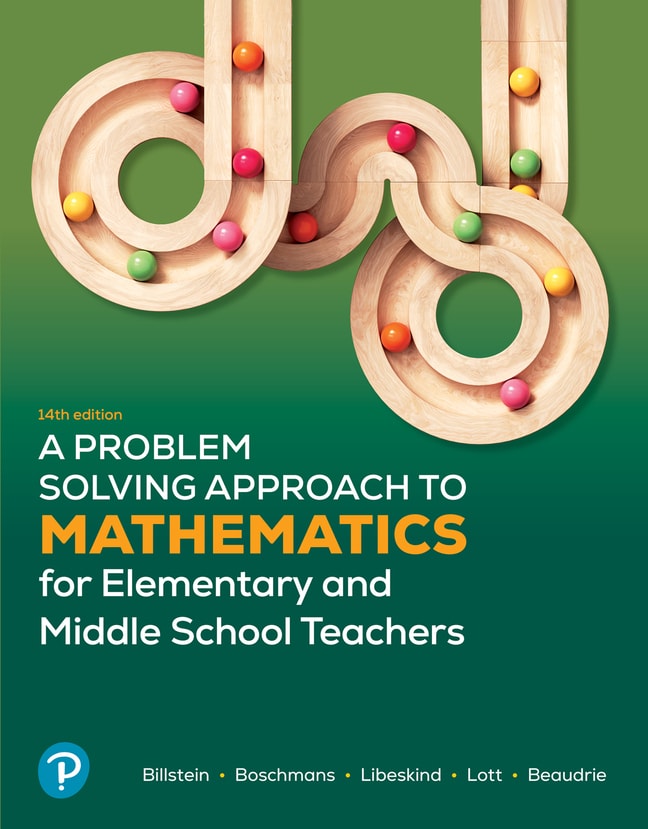
A Problem Solving Approach to Mathematics for Elementary and Middle School Teachers, 14th edition
- Rick Billstein
- , Barbara Boschmans
- , Shlomo Libeskind
- , Johnny Lott
- , Brian Beaudrie

- Find it fast
Quickly navigate your eTextbook with search
- Stay organized
Access all your eTextbooks in one place
- Easily continue access
Keep learning with auto-renew
A Problem Solving Approach to Mathematics for Elementary and Middle School Teachers is designed to help you become an outstanding elementary or middle school math teacher. Using a concept-rich, skill-based approach, it will not only help you learn the math but will serve as a useful future reference for professional development and standards.
The 14th Edition has been revised to prepare you more effectively for your own classroom. Material is reorganized throughout to better reflect the topics that you will likely be teaching. Expanded and updated content is informed by recent Standards for Mathematical practice. A new “Illustrative Mathematics K-8 Student Tasks” feature helps to show you math tasks that real elementary and middle school students may be asked to do. Chapter-opening problems are revised throughout for enhanced relevance and student interest; exercise sets are updated and reorganized in every chapter; and much more.
Published by Pearson (December 10th 2024) - Copyright © 2026
ISBN-13: 9780138243227
Subject: Math for Future Teachers
Category:
1. Problem Solving
- 1-1 Mathematics and Problem Solving
- 1-2 Explorations with Patterns
- Chapter 1 Review
2. Introduction to Logic and Sets
- 2-1 Reasoning and Logic: An Introduction
- 2-2 Describing Sets 2-3 Other Set Operations
- Chapter 2 Review
3. Numeration Systems and Whole Number Operations
- 3-1 Numeration Systems
- 3-2 Addition of Whole Numbers
- 3-3 Subtraction of Whole Numbers
- 3-4 Multiplication of Whole Numbers
- 3-5 Division of Whole Numbers
- Chapter 3 Review
4. Number Theory
- 4-1 Divisibility
- 4-2 Prime and Composite Numbers
- 4-3 Greatest Common Divisor and Least Common Multiple
- Chapter 4 Review
5. Integers
- 5-1 Addition and Subtraction of Integers
- 5-2 Multiplication and Division of Integers
- Chapter 5 Review
6. Rational Numbers and Proportional Reasoning
- 6-1 The Set of Rational Numbers
- 6-2 Addition, Subtraction, and Estimation with Rational Numbers
- 6-3 Multiplication, Division, and Estimation with Rational Numbers
- 6-4 Proportional Reasoning
- Chapter 6 Review
7. Decimals, Percents, and Real Numbers
- 7-1 Terminating Decimals
- 7-2 Operations on Decimals
- 7-3 Repeating Decimals
- 7-4 Percents
- 7-5 Real Numbers
- Chapter 7 Review
8. Algebraic Thinking
- 8-1 Expressions and Equations
- 8-2 Solving Equations and Inequalities with One Variable
- 8-3 Functions and Graphing Equations
- 8-4 Solving Systems of Equations and Inequalities with Two Variables
- Chapter 8 Review
9. Introductory Geometry
- 9-1 Basic Notions
- 9-2 Curves, Polygons, and Symmetry
- 9-3 More About Angles
- 9-4 Geometry in Three Dimensions
- Chapter 11 Review
10. Congruence and Similarity
- 10-1 Congruency Through Constructions
- 10-2 Additional Congruence Theorems
- 10-3 Additional Constructions
- 10-4 Similarity
- Chapter 10 Review
11. Measurement
- 11-1 Linear Measure
- 11-2 Concept of Area and the Pythagorean Theorem
- 11-3 Areas of Polygons and Circles
- 11-4 Surface Areas
- 11-5 Volume and Mass
- Chapter 11 Review
- Technology Modules
12. Transformations
- 12-1 Translations, Rotations, and Tessellations
- 12-2 Reflections and Glide Reflections
- 12-3 Dilations 935
- Chapter 12 Review
13. Data Science and Statistics
- 13-1 The Statistical Problem-Solving Process
- 13-2 Visualizing Univariate Data
- 13-3 Visualizing Bivariate Data
- 13-4 Measures of Central Tendency and Variation
- Chapter 13 Review
14. Probability
- 14-1 Determining Probabilities
- 14-2 Multistage Experiments and Modeling Games
- 14-3 Simulations and Applications in Probability
- 14-4 Permutations and Combinations in Probability
- Chapter 14 Review
Modules (online)
- Module A: Clock and Modular Arithmetic
- Module B: Using Real Numbers in Equations
- Module C: Networks
- Module D: Trigonometry Ratios via Similarity
- Module E: Spreadsheets
- Module F: Graphing Calculators
- Module G: GeoGebra